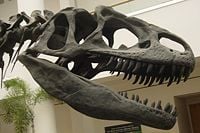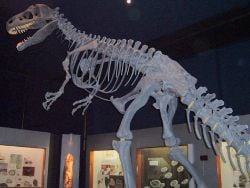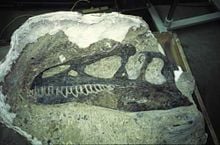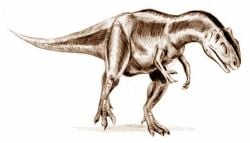Allosaurus
| Allosaurus | ||||||||||||||||||
|---|---|---|---|---|---|---|---|---|---|---|---|---|---|---|---|---|---|---|
 Replica of Allosaurus skull (San Diego Natural History Museum).
| ||||||||||||||||||
|
Extinct (fossil)
| ||||||||||||||||||
| Scientific classification | ||||||||||||||||||
| ||||||||||||||||||
| ||||||||||||||||||
|
Allosaurus was a large (up to 9.7 m long) bipedal (moving on two legs), carnivorous dinosaur that lived during the late Jurassic period, 155 to 145 million years ago. Allosaurus is the most common large predator whose fossils are found in the Morrison Formation, a distinctive sequence of Late Jurassic sedimentary rock that in the western United States and Canada—the most fertile source of dinosaur fossils in North America.
The name Allosaurus comes from the Greek allos/αλλος, meaning "strange" or "different" and saurus/σαυρος, meaning "lizard" or "reptile" (Liddell and Scott 1987). It was named "different lizard" because its vertebrae were different from those of other dinosaurs known at the time of its discovery.
Allosaurus was named by famous palenotologist O. C. Marsh, who found the type species during the famed competition with E. D. Cope. Competition can spur individuals to greater accomplishment. However, the Marsh-Cope competition was so vicious that that there were efforts to destroy each other's reputation. There were allegations of spying, stealing workers, stealing fossils, treaty violations, and bribery. Marsh's camp was even accused of dynamiting a fossil site rather than let it fall into Cope's hands.
Allosaurus shared the landscape with several genera of giant sauropods such as Apatosaurus, Diplodocus, and Camarasaurus as well as other herbivores such as Stegosaurus and Camptosaurus, all of which may have been potential prey.
Description

Allosaurus was a typical large theropod, having a massive skull on a short neck, a long tail, and reduced forelimbs. Theropods were a group of bipedal saurischian dinosaurs that first appear during the Late Triassic about 220 million years ago and were the sole large terrestrial carnivores from the Early Jurassic until the end of the Cretaceous, about 65 million years ago. The most distinctive feature of Allosaurus was a pair of blunt horns, just above and in front of the eyes. Although short in comparison to the hind limbs, the forelimbs were massive and bore large, eagle-like claws. The skull showed evidence of being composed of separate modules, which could be moved in relation to one another, allowing large pieces of meat to be swallowed.
The skeleton of Allosaurus, like other theropods, displayed bird-like features, such as a furcula (wishbone) and neck vertebrae hollowed by air sacs.
The animal had an average length of 7-9 meters (~30 feet), with the largest definitive Allosaurus specimen (AMNH 680) measuring 9.7 m (32 ft). Several gigantic specimens have been attributed to Allosaurus, but may in fact belong to other genera. The closely related genus Saurophaganax (OMNH 1708) reached 10.9 m (36 ft) in length, and has sometimes been included in the genus Allosaurus as Allosaurus maximus. Recent studies, however, lend support to the idea that it should remain a separate genus (Chure 2000). Another specimen, assigned to the genus Epanterias (AMNH 5767), may have measured 12.1 m in length. But scientists now think Epanterias may be a species of Allosaurus or Saurophaganax (Mortimer 2003).
Finds
Allosaurus is the most common theropod fossil in the vast tract of dinosaur-bearing rock of the American Southwest known as the Morrison Formation. Remains have been recovered in U.S. states of Montana, Wyoming, South Dakota, Colorado, Oklahoma, New Mexico, and Utah. One species of Allosaurus has been described from Portugal, A. europaeus (Mateus et al. 2006).
The first Allosaurus fossil to be described was a "petrified horse hoof" given to Ferdinand Vandiveer Hayden in 1869, by the natives of Middle Park, near Granby, Colorado. It was actually a caudal vertebra (a tail bone), which Joseph Leidy tentatively assigned first to the Poekilopleuron genus and later to a new genus, Antrodemus (Leidy 1870). However, it was Othniel Charles Marsh (1877) who gave the formal name Allosaurus fragilis to the genus and type species in 1877, based on much better material he found, including a partial skeleton, from Garden Park, north of Cañon City, Colorado. The species epithet fragilis is Latin for 'fragile', referring to lightening features in the vertebrae.
A famous fossil bed can be found in the Cleveland Lloyd Dinosaur Quarry in Utah. This fossil bed contains over 10,000 bones, mostly of Allosaurus, intermixed with the remains of other dinosaurs, such as Stegosaurus and Ceratosaurus. It is still a mystery how the remnants of so many animals were preserved in one place. The ratio of fossils of carnivorous animals to fossils of herbivores is normally very small. Findings like these can be explained by pack hunting, although this is difficult to prove. Another possibility is that the Cleveland Lloyd site formed a "predator trap," similar to the La Brea Tar Pits, that caused large numbers of predators to become mired in an inescapable sediment.
The material from the Cleveland Lloyd Dinosaur Quarry specimen is much smaller and more lightly-built than the huge and robust Allosaurus from Brigham Young University's Dry Mesa Quarry. It is unclear how many species of Allosaurus there are.
"Big Al"
One of the more significant finds was the 1991 discovery of "Big Al" (MOR 593), a 95% complete, partially articulated, specimen that measured 7.5-8 meters (24-26 feet) in length. Nineteen bones were broken or showed signs of infection, which probably contributed to the animal's death (Hanna 2002). The fossils were excavated near Shell, Wyoming by the Museum of the Rockies and the University of Wyoming Geological Museum. The completeness of this skeleton, not its size, is what gave Big Al its name—the individual itself was below the average size for Allosaurus fragilis, and may have been a subadult or a new, smaller species. The specimen was described by Breithaupt (1996).
This skeleton was initially discovered by a Swiss team, led by Kirby Siber. The same team later excavated a second Allosaurus, "Big Al Two," which is the best preserved skeleton of its kind to date.
Allosaurid relatives
- An allosaurid astragalus (ankle bone) was found at Cape Patterson, Victoria in early Cretaceous beds in Southeastern Australia. This is notable as this part of Australia was within the Antarctic Circle at the time.
In popular culture
Along with its distant relative Tyrannosaurus, Allosaurus has come to represent the quintessential large, carnivorous dinosaur in popular culture. Allosaurus has been featured in such films as The Lost World, One Million Years B.C.E., The Valley of Gwangi, A Sound of Thunder, and others. It was the top predator in Arthur Conan Doyle's novel, The Lost World, appeared in episodes of BBC's series Walking with Dinosaurs, and appeared in the television show When Dinosaurs Roamed America.
ReferencesISBN links support NWE through referral fees
- Breithaupt, B. H. 1996. The Discovery of a Nearly Complete Allosaurus From the Jurassic Morrison Formation, Eastern Bighorn Basin, Wyoming. In C. E. Brown, S. C. Kirkwood, and T. S. Miller, eds. Forty-Seventh Annual Field Conference Guidebook: 309-313.
- Chure D. J. 2000. A New Species of Allosaurus From the Morrison Formation of Dinosaur National Monument (Utah-Colorado) and a Revision of the Theropod Family Allosauridae. Ph.D. dissertation, Columbia University.
- Hanna, R. R. 2002. Multiple Injury and Infection in a Sub-adult Theropod Dinosaur (Allosaurus fragilis) With Comparisons to Allosaur Pathology in the Cleveland-Lloyd Dinosaur Quarry Collection. Journal of Vertebrate Paleontology 22(1): 76-90.
- Leidy, J. 1870. Remarks on Poicilopleuron valens, Clidastes intermedius, Leiodon proriger, Baptemys wyomingensis, and Emys stevensonianus. Proc. Acad. Nat. Sci. Philadelphia 1870: 3-5.
- Liddell, H. G., and R. Scott. 1987. A Lexicon Abridged from Liddell and Scott's Greek-English Lexicon. Oxford: Clarendon Press. ISBN 0199102074
- Marsh, O. C. 1877. Notice of New Dinosaurian Reptiles From the Jurassic Formation. American Journal of Science and Arts 14: 514-516.
- Mateus, O., A. Walen, and M. T. Antunes. 2006. The Large Theropod Fauna of the Lourinha Formation (Portugal) and Its Similarity to That of the Morrison Formation, With a Description of a New Species of Allosaurus. New Mexico Museum of Natural History and Science Bulletin: 36.
- Mortimer, M. 2003. And the largest theropod is.... Dinosaur Mailing List, Cleveland Museum of Natural History. Retrieved March 18, 2007.
External links
All links retrieved July 21, 2023.
- Allosaurus Geological Museum, University of Wyoming.
Credits
New World Encyclopedia writers and editors rewrote and completed the Wikipedia article in accordance with New World Encyclopedia standards. This article abides by terms of the Creative Commons CC-by-sa 3.0 License (CC-by-sa), which may be used and disseminated with proper attribution. Credit is due under the terms of this license that can reference both the New World Encyclopedia contributors and the selfless volunteer contributors of the Wikimedia Foundation. To cite this article click here for a list of acceptable citing formats.The history of earlier contributions by wikipedians is accessible to researchers here:
The history of this article since it was imported to New World Encyclopedia:
Note: Some restrictions may apply to use of individual images which are separately licensed.

